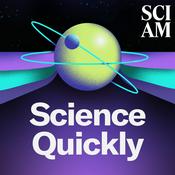1214 episódios

Are Raccoons On The Road To Domestication?
08/1/2026 | 18min
What does it mean to be a wild animal in a world dominated by humans? A recent study found that city-dwelling raccoons’ snouts are getting shorter—a sign of domestication. Another study on dark-eyed juncos living on a Los Angeles college campus found that their beaks changed shape during the COVID-19 lockdown, when there wasn’t as much food and trash on campus. Evolutionary biologist Pamela Yeh and animal domestication expert Raffaela Lesch join Host Flora Lichtman to discuss how wildlife is evolving in urban areas, what it means to be domesticated, and when we can expect to have a pet raccoon sleeping at the foot of the bed. Guests:Dr. Pamela Yeh is a professor of ecology and evolutionary biology at UCLA.Dr. Raffaela Lesch is an assistant professor of biology at the University of Arkansas at Little Rock.Transcripts for each episode are available within 1-3 days at sciencefriday.com. Subscribe to this podcast. Plus, to stay updated on all things science, sign up for Science Friday's newsletters.

The Community Group Rethinking LA's Approach To Wildfires
07/1/2026 | 14min
A year ago this week, the Eaton and Palisades fires broke out in Los Angeles, and ultimately became one of the most destructive urban fire events in recent history. Today we’ll hear about a community brigade that is taking firefighting into its own hands through a technique called “home hardening.”Journalist Adriana Cargill, host of the new podcast “The Palisades Fire: A Sandcastle Special” from PRX, embedded with this group to understand what the future of firefighting could look like. She and Jack Cohen, a former research scientist with the USDA Forest Service, join Host Flora Lichtman to explain the science behind how people can prevent their own homes from burning.Guests:Adriana Cargill is a multimedia journalist and host of the podcast “The Palisades Fire: A Sandcastles Special.” She is based in Los Angeles, California.Dr. Jack Cohen is a former research physical scientist with the USDA Forest Service, based in Missoula, Montana.Transcripts for each episode are available within 1-3 days at sciencefriday.com. Subscribe to this podcast. Plus, to stay updated on all things science, sign up for Science Friday's newsletters.

What Should Astronauts Do First When They Reach Mars?
06/1/2026 | 17min
When humans finally land on Mars, what should they do? A new report from the National Academies of Sciences, Engineering, and Medicine lays out the science objectives for a crewed Mars mission. Planetary scientist Lindy Elkins-Tanton, who co-chaired the report committee, joins Host Flora Lichtman to talk about the plans to send people to Mars.We’ll also get an update on the mission to survey the asteroid Psyche. Elkins-Tanton tells us how she managed the team that made the Psyche mission possible, and what she learned from her mistakes. Guest: Dr. Lindy Elkins-Tanton is a planetary scientist. She’s the head of NASA’s Psyche mission and director of UC Berkeley’s Space Sciences Laboratory. Transcripts for each episode are available within 1-3 days at sciencefriday.com. Subscribe to this podcast. Plus, to stay updated on all things science, sign up for Science Friday's newsletters.

Can The Rise In Solar Power Balance Out Clean Energy Cuts?
05/1/2026 | 17min
Since President Trump returned to office, his administration has been aggressive in rolling back clean energy initiatives. Trump’s “big beautiful bill” ended tax credits for solar panels and electric vehicles. And the EPA is moving to cancel $7 billion dollars in federal grants that were intended to help low- and middle-income families install solar on their homes.But that isn’t the whole story. Texas, California, and other states are bringing so much solar and battery power online that in March, fossil fuels generated less than half the electricity in the US for the first time ever. And internationally, solar has gotten so cheap to build and install that it’s fundamentally transforming many countries’ power grids.So where exactly does solar adoption stand in the US and across the world right now?In August, climate activist Bill McKibben joined Host Ira Flatow to talk about the recent wins and future challenges that sun-powered energy faces, which he writes about in his new book Here Comes The Sun: A Last Chance for the Climate and a Fresh Chance for Civilization.Read an excerpt from Here Comes The Sun.Guest: Bill McKibben is a climate activist and founder of Third Act. He’s based in Middlebury, Vermont.Transcript for this episode is available at sciencefriday.com. Subscribe to this podcast. Plus, to stay updated on all things science, sign up for Science Friday's newsletters.

Are Ultramarathoners Just Built Different?
02/1/2026 | 17min
‘Tis the season for exercise resolutions. For a select few, an ultramarathon—a race of 50, 100, or even more miles—may be on the table for 2026. But is there a limit to what our bodies can endure? And what makes ultramarathoners capable of these tremendous feats? Joining Host Flora Lichtman are sports medicine expert Brandee Waite and biological anthropologist Andrew Best.Guests:Dr. Brandee Waite is the director of UC Davis Health Sports Medicine in Sacramento, California.Dr. Andrew Best is an assistant professor of biology at the Massachusetts College of Liberal Arts.Transcripts for each episode are available within 1-3 days at sciencefriday.com. Subscribe to this podcast. Plus, to stay updated on all things science, sign up for Science Friday's newsletters.
Mais podcasts de Ciência
Podcasts em tendência em Ciência
Sobre Science Friday
Ouça Science Friday, Ciência Suja e muitos outros podcasts de todo o mundo com o aplicativo o radio.net

Obtenha o aplicativo gratuito radio.net
- Guardar rádios e podcasts favoritos
- Transmissão via Wi-Fi ou Bluetooth
- Carplay & Android Audo compatìvel
- E ainda mais funções
Obtenha o aplicativo gratuito radio.net
- Guardar rádios e podcasts favoritos
- Transmissão via Wi-Fi ou Bluetooth
- Carplay & Android Audo compatìvel
- E ainda mais funções


Science Friday
baixe o aplicativo,
ouça.




































